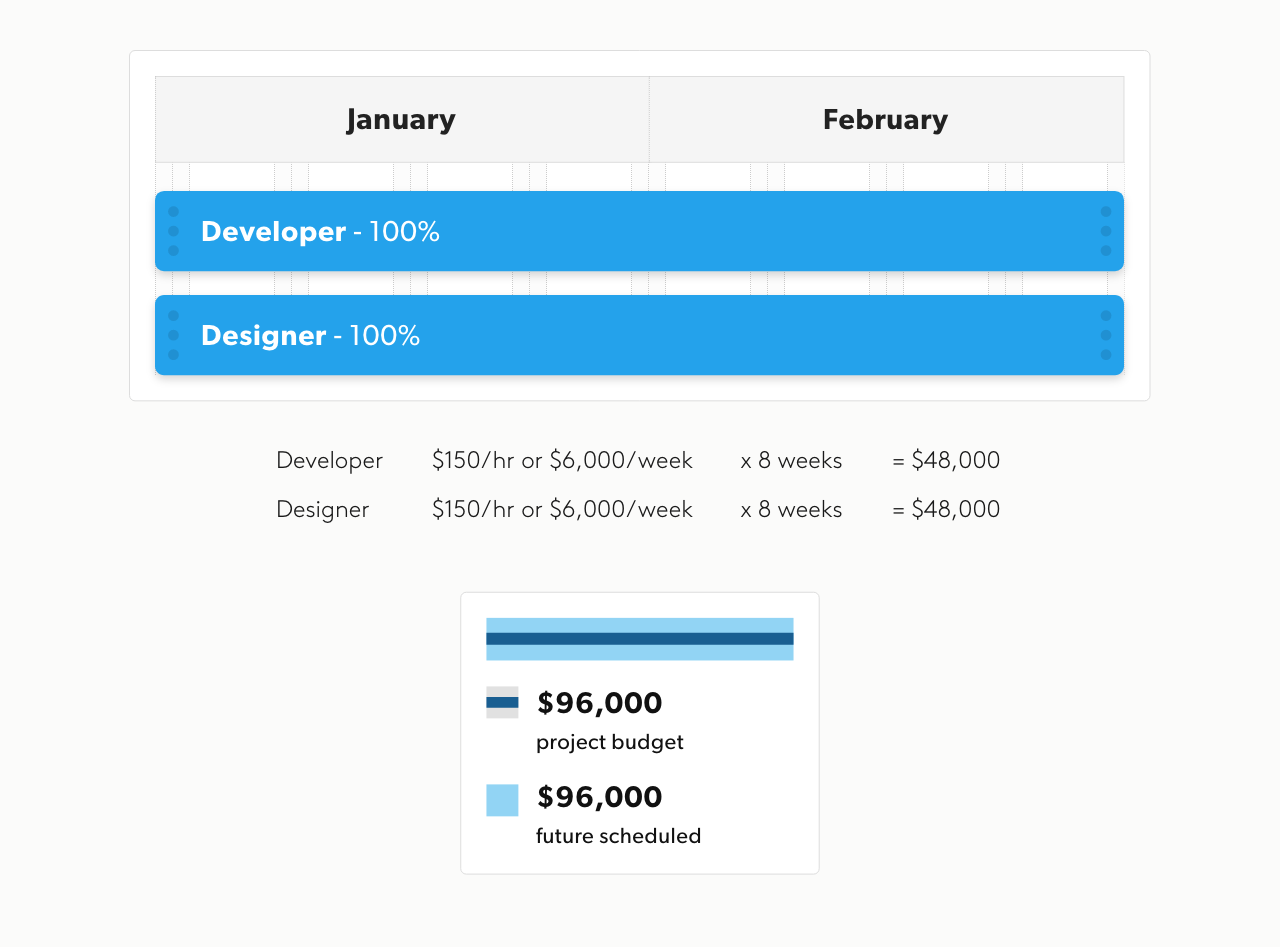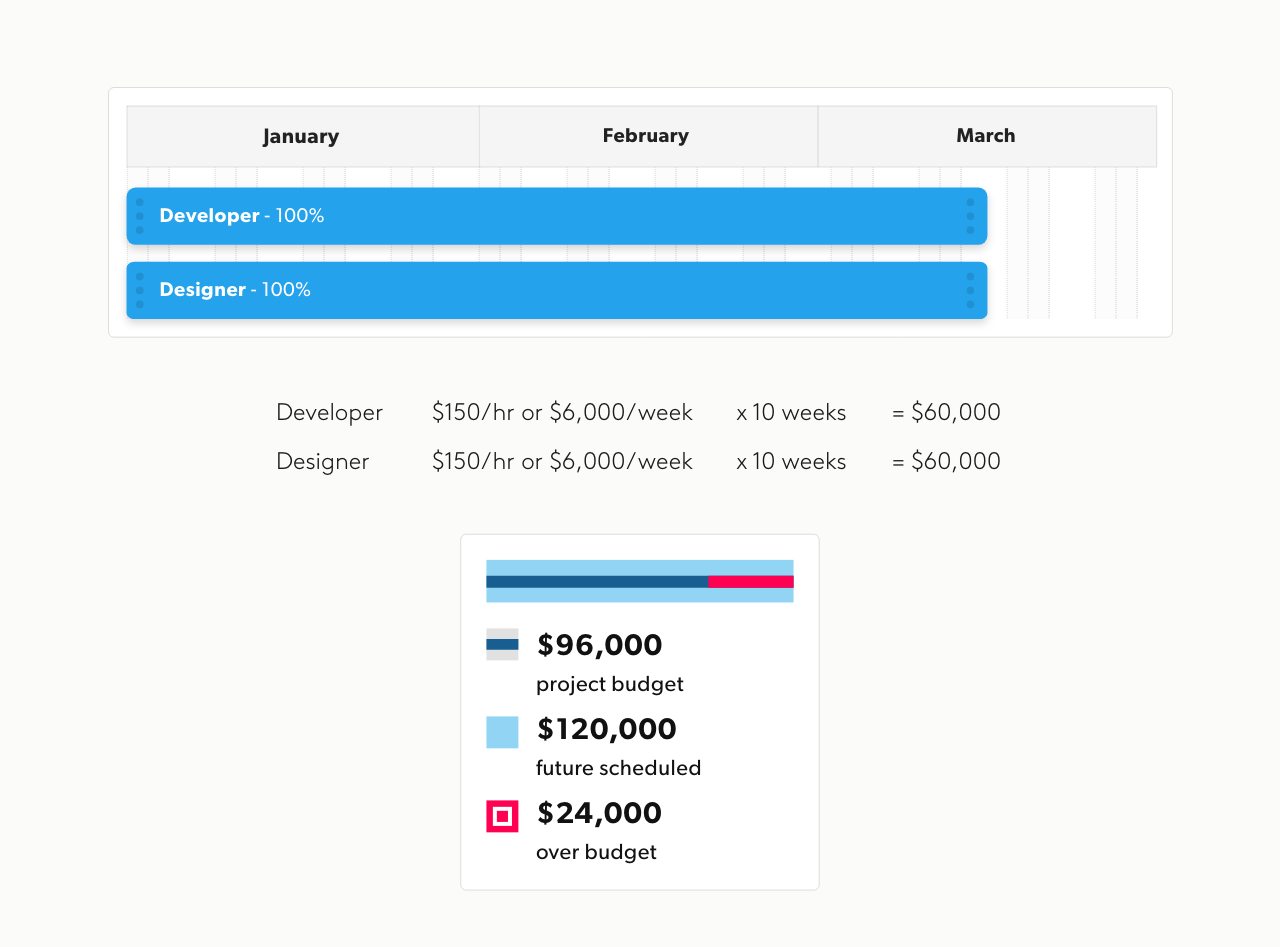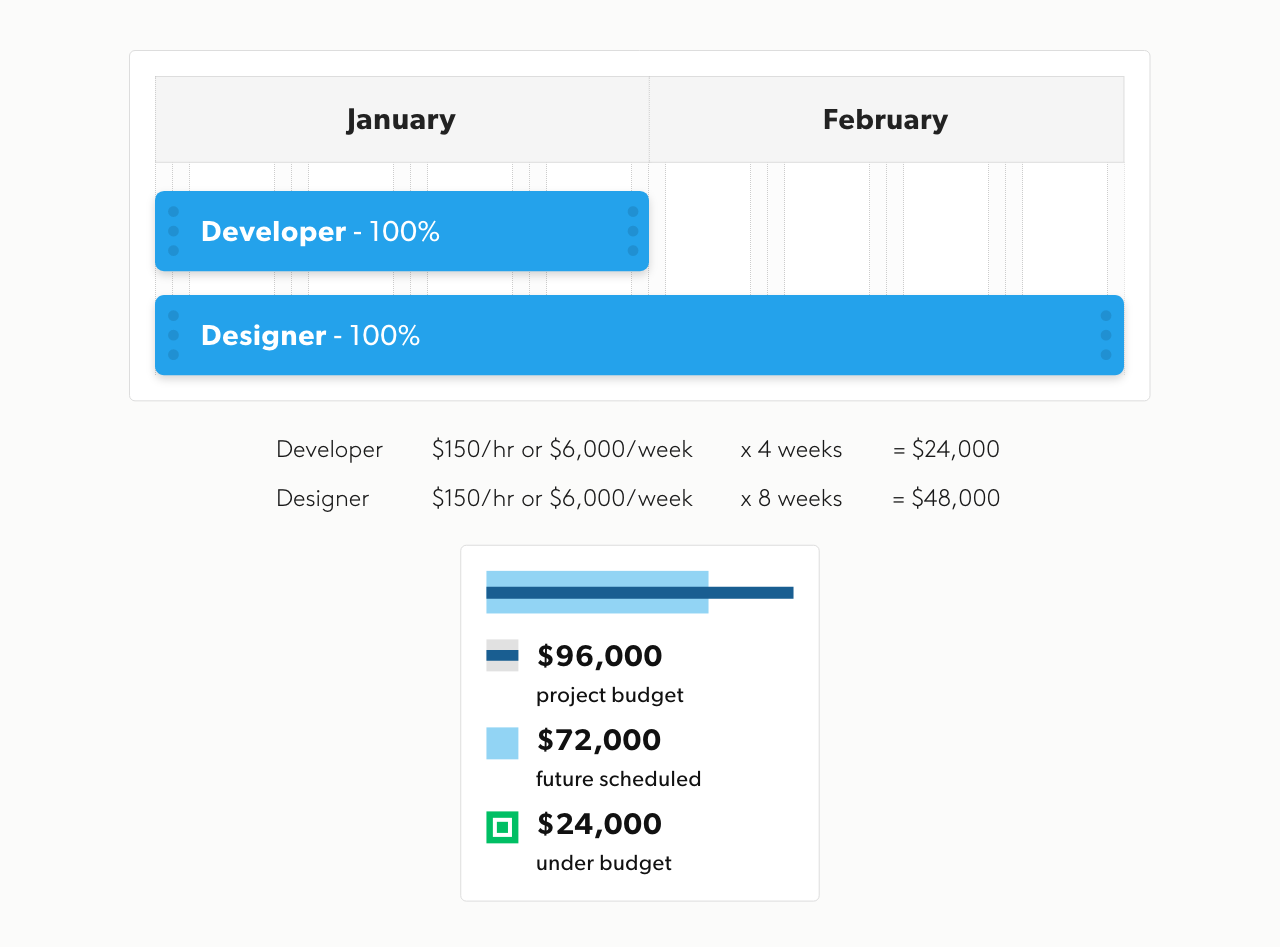Here are some best practices for getting started with Resource Management.
Project schedule tips
Schedule upfront
Scheduling a project fully upfront provides real-time insight into the project's profitability.
The cost of a fully scheduled project must be in line with the budget before it begins, so you are mapping the work plan for the project to the actual fee you estimated when you scheduled the project.
For example, if the budget is $96,000 and you schedule two people full-time for two months at $150/hour, the future scheduled amount should match the budget.
As your team reports their hours, you can immediately see the impact on the forecasted budget.
Use placeholders
If you need more clarification about the team assigned to your project, setting up a placeholder for the relevant discipline or department (such as Visual Designer) can be a helpful strategy. This placeholder can have a bill rate, so you know the impact on the schedule.
Once you've identified the right person, you can assign the project to them. If you make scheduling decisions weekly or daily, you can split the placeholder’s assignment, reassigning each segment to another person on the team.
About bill rates
Determining bill rates
When you set your bill rates, consider the following:
- Cost of work: This includes staff salaries and benefits, as well as overhead costs of non-billable people, rent, and other operational expenses.
- Utilization goals: The percentage of work hours that are considered direct labor (project work that clients pay for) as opposed to indirect labor (work that’s considered overhead, or work in-between clients’ projects)
- Utilization differs per organization, but it’s typically in the range of 50% – 75%. Higher than 75% may be unhealthy for an organization over a long period of time.
- Profitability goals: The profit margin that the organization is aiming for. This differs across organizations, but is typically in the 15%-25% range.
- Fully burdened rate: The true cost per production hour for each team member, you can calculate exactly how much you need to charge per hour for that person to meet your gross profit goals on the projects.
- Pricing multiplier: You can multiply the hourly rate by the pricing multiplier. A typical pricing multiplier is between three and five. Multipliers vary greatly and depend on your industry. Research what multiplier makes the most sense for your team.
Labor expenses and overhead expenses change over time. Recalculate this rate once or twice a year to make sure it’s current and adjust the bill rates for new projects as needed.
Calculate estimated project costs
When presenting your clients with a price for your work, base your estimate and calculations on this external bill rate. Figure out how much time it would take to complete the work and multiply that by the hourly rate.
It may be better to communicate this to the client as a fixed bid and not to divulge the hourly rate calculations that went into it. Otherwise, it can lead to situations where you’re negotiating around every hour, rather than the value of the work performed. Even when project durations are unpredictable, as in software development work, for example, you can still calculate in blocks of time, and with an upper budget limit.
Set up your project budget in Resource Management
Fixed-bid projects
For a fixed-bid project, you bid to complete a defined set of work for a certain amount of money. Your budget is the price you charge the client.
Retainers
For a retainer, the client pays a fee for a set amount of work, but the scope isn’t typically defined upfront. There may be a not-to-exceed agreement for the budget. With retainers, the budget is dependent on how you want to break up the retainer.
For example, it could be a series of one-month projects or phases or a year-long project.
Time and materials
For time and materials projects, you get paid for actual hours worked. You can leave the budget blank and simply keep track of incurred fees. You can also enter a target amount or the maximum agreed-upon amount. For time and material projects, you might need to adjust bill rates to reflect the agreed-upon markup for worked hours.
Estimate the budget for a new project
In Resource Management, you can create a new project and assign people (or placeholders for roles and disciplines) for the estimated time it will take. The resulting future scheduled amount is the estimate for this project.
The project below shows one designer and one developer for two months, at $150/h, totaling $96,000 in billable labor.

If possible, keep estimates and subsequent proposals high level rather than calculating every minor expense upfront.
When the project becomes a reality, this estimate becomes the budget. When you add future assignments to the project, the resulting future scheduled amount should be up to the budget.
When you schedule too many people or too much time on a project, it will be immediately apparent that this project will go over budget.

If you don't schedule enough people for a project, you may not have the right resources available when you need them.

Tips to track and analyze time and budget
Don’t track more than you need
It takes time to track time, so it's more efficient to track as little as possible to meet your organization’s goals.
- Some organizations don’t track time at all. They assume what was planned is what was incurred. These teams calculate incurred hours and amounts as confirmed and unconfirmed past-scheduled hours.
- Other organizations need more information, and record only the hours needed for each project. They set time tracking to hours and minutes.
- Detailed tracking requires your team enter notes for each time entry. This method allows for more filtering and analysis of reported hours.
Enable good decision-making
People who do the work know the best time to do it, as long they have clear expectations about deadlines, priorities, and how long the work should take.
It’s best to make assignments as high-level as possible, for example, a week-long assignment of 20% of a person’s allocation rather than a day-long assignment of eight hours. This way, people can plan their entire week around higher-level expectations.
Analyze across segments
Reports allow you to group incurred and future hours, budgets and utilizations, and more, from different perspectives. You can analyze the hours for one project, all hours grouped by client, discipline, role or month, or many other pivots.
Analyzing reports helps you make strategic adjustments going forward. You might find certain people always need more time for work or certain clients always go over budget. With these details, you can adjust your estimates. For that client that always runs over, you might add three extra weeks when you start your next project with them.
You can create project templates with suggested budgets for certain activities. Report data gives you real insights into how to set up those templates, improving your baseline planning every time.


